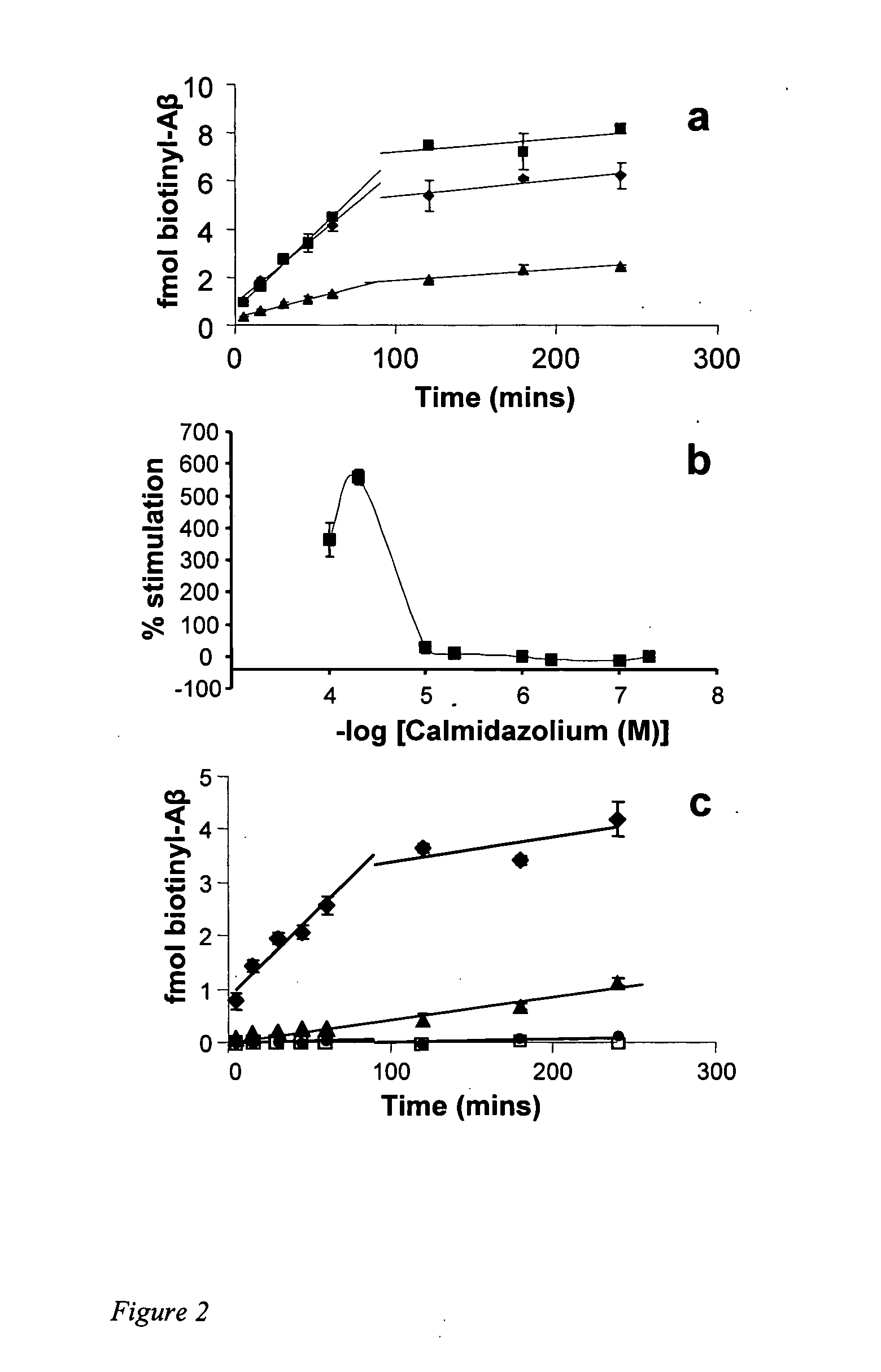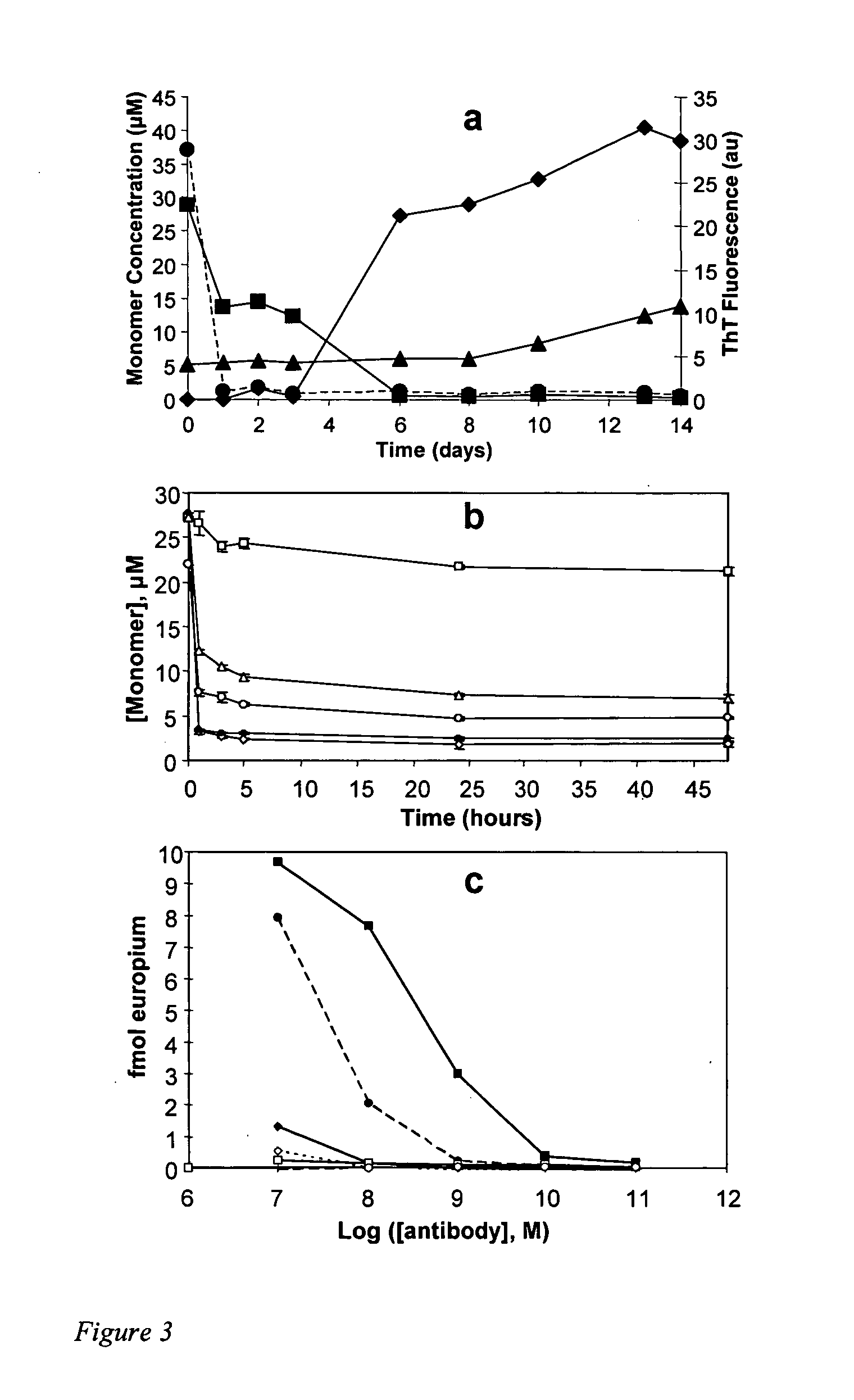Stabilized A-beta protofibrillar aggregates
- Summary
- Abstract
- Description
- Claims
- Application Information
AI Technical Summary
Benefits of technology
Problems solved by technology
Method used
Image
Examples
example 1
Materials and Methods
[0091] Below are examples of specific embodiments for carrying out the present invention. The examples are offered for illustrative purposes only, and are not intended to limit the scope of the present invention in any way. Efforts have been made to ensure accuracy with respect to numbers used (e.g., amounts, temperatures, etc.), but some experimental error and deviation should, of course, be allowed for.
[0092] The practice of the present invention will employ, unless otherwise indicated, conventional methods of protein chemistry, biochemistry, recombinant DNA techniques and pharmacology, within the skill of the art. Such techniques are explained fully in the literature. See, e.g., T. E. Creighton, Proteins: Structures and Molecular Properties (W. H. Freeman and Company, 1993); A. L. Lehninger, Biochemistry (Worth Publishers, Inc., current addition); Sambrook, et al., Molecular Cloning: A Laboratory Manual (2nd Edition, 1989); Methods In Enzymology (S. Colowic...
example 2
Library Screening
[0103] We screened a small library of 640 compounds, the LOPAC library (Sigma), using a microplate-based Aβ elongation assay. In this assay, plastic wells containing immobilized fibrils are incubated with a biotin-tagged monomer in the presence or absence of potential modifiers (13, 18). We found a number of compounds with potent abilities to enhance deposition of the biotin-tagged Aβ(1-40) (FIG. 1). Seven of the compounds were selected for further analysis:—amiloride HCl, phenamil methane sulfonate, naftopidil dihydrochloride, NPC 15437 dihydrochloride, calmidazolium chloride (R24571), 5-(nonoxyl)-tryptamine hydrogen oxalate, and L-α-methyl DOPA. The compounds have a wide variety of structures and biochemical properties. The structures of these seven compounds are shown in FIG. 9, along with the percent stimulation observed in the experiments.
[0104] The most potent of these compounds is calmidazolium chloride (CLC, FIG. 1 insert), which at 100 μM stimulates the d...
example 3
Characterization of CLC Stabilized Protofibrillar Aggregates
[0106] Although clearly distinct structures, Aβ mature fibrils exhibit a number of similarities to protofibrils and CLC-Aβ aggregates, including a fundamental fibrillar character in the EM, a shared epitope for the antibody WO1, and common possession of a subset of unusually stable H-bonds. Both mature amyloid fibrils and CLC aggregates appear to be assembled from very similar conformations of the peptide, as revealed by scanning proline mutagenesis, which can reveal sites of restrictive peptide backbone geometry within fibrils (15, 22).
[0107] We characterized the activity of CLC in the microplate assay in more detail. The time course of Aβ deposition in the presence of CLC yields a pattern similar to the reaction without added compound (FIG. 2a), suggesting a simple acceleration of the normal mechanism. However, when the assay is repeated on a microplate lacking Aβ fibrils, the dramatic deposition of biotinylated Aβ in t...
PUM
| Property | Measurement | Unit |
|---|---|---|
| Structure | aaaaa | aaaaa |
| Immunogenicity | aaaaa | aaaaa |
Abstract
Description
Claims
Application Information
 Login to View More
Login to View More - R&D
- Intellectual Property
- Life Sciences
- Materials
- Tech Scout
- Unparalleled Data Quality
- Higher Quality Content
- 60% Fewer Hallucinations
Browse by: Latest US Patents, China's latest patents, Technical Efficacy Thesaurus, Application Domain, Technology Topic, Popular Technical Reports.
© 2025 PatSnap. All rights reserved.Legal|Privacy policy|Modern Slavery Act Transparency Statement|Sitemap|About US| Contact US: help@patsnap.com



